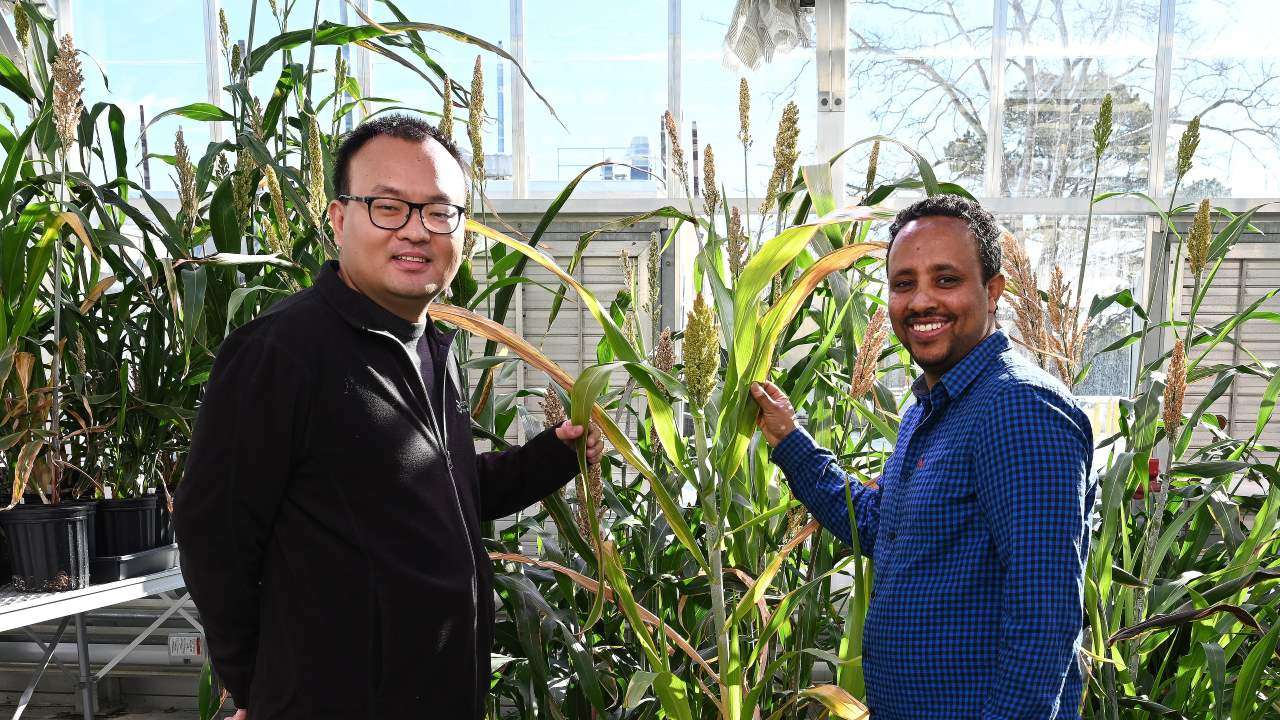Feature Image: Brookhaven Lab Biologist Meng Xie (L) and postdoctoral fellow Dimiru Tadesse with sorghum plants like those used in this study. Note that these plants are flowering, unlike those the scientists engineered to delay flowering indefinitely to maximize their accumulation of biomass. Credit: Kevin Coughlin, Brookhaven National Laboratory
Study points to genetic strategies for altering crop-plant flowering time to increase production of fuel-generating biomass.
Scientists at the U.S. Department of Energy’s (DOE) Brookhaven National Laboratory and Oklahoma State University have identified key genes and the mechanism by which they control flowering in sorghum, an important bioenergy crop. The findings, just published in the journal New Phytologist, suggest strategies to delay sorghum flowering to maximize plant growth and the amount of biomass available for generating biofuels and bioproducts.
“Our studies elucidate the gene regulatory network controlling sorghum flowering and provide new insights into how these genes could be leveraged to improve sorghum for achieving bioenergy goals,” said Brookhaven Lab biologist Meng Xie, one of the leaders of the research.
Sorghum is particularly well suited for sustainable agriculture because it can grow on marginal lands in semiarid regions and can tolerate relatively high temperatures. Like many plants, its growth and flowering (reproductive) cycles are regulated by the duration of daily sunlight. And once plants start to flower, they stop growing, which has important implications for the accumulation of biomass.
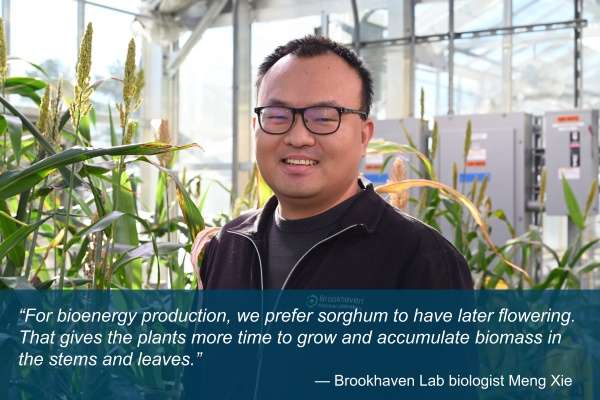
Credit: Kevin Coughlin, Brookhaven National Laboratory
For example, one natural sorghum variety can reach nearly 20 feet in height, only transitioning to the reproductive flowering phase near the end of the summer growing season when the duration of daylight diminishes. Other “day-neutral” lines flower earlier, after reaching about three feet in height, producing less vegetation but more grain.
“While these earlier flowering varieties might be preferable when growing sorghum as a food source, for bioenergy production, we prefer sorghum to have later flowering. That gives the plants more time to grow and accumulate biomass in the stems and leaves,” Xie said.
Understanding the genes that control these different flowering times — a long-sought goal for plant scientists — might point to ways to optimize sorghum for either desired outcome.
With the bioenergy production goal in mind, the Brookhaven team started by exploring a gene that had been previously identified as associated with later flowering, known as SbGhd7. The association between this gene and later flowering was based on statistical predictions from genome-wide studies, but it had not been validated with experimental data — and its mechanism of action was completely unknown.
“Our study provided direct evidence to support this gene’s function in flowering control and also helped us understand its molecular mechanism,” said Brookhaven Lab postdoctoral fellow Dimiru Tadesse, first author on the study.
Overexpression Eliminates Flowering
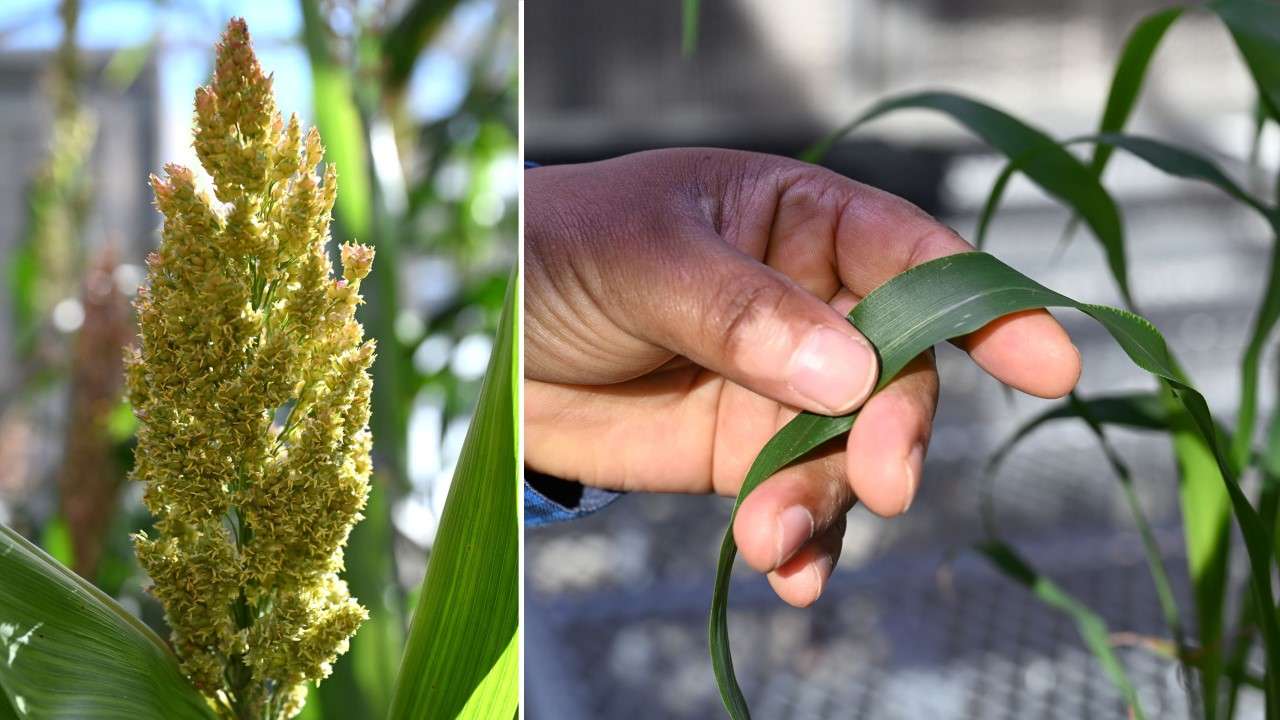
When sorghum begins producing grain-laden flowers (L) the plants stop growing. Brookhaven Lab and Oklahoma State University scientists discovered the genes that control flowering time and modified plants to delay flowering. Credit: Kevin Coughlin, Brookhaven National Laboratory
The first evidence came from transgenic sorghum plants engineered at Oklahoma State to overexpress the purported flowering-control gene. Sorghum varieties that overexpressed this gene — that is, made its protein product in abundance — didn’t just delay flowering; they never flowered at all.
“This was a dramatic difference from what happens in rice plants when they overexpress their version of this same gene,” Xie noted. “In rice, overexpression of this gene delays flowering for eight to 20 days — not forever!”
The transformed sorghum plants had more than twice the biomass of control plants.
To find out why, Xie and his team wanted to unravel the details of how this gene operated within cells. Their goal was to see how the protein that is coded for by the flowering-repressor gene interacted with other genes.
Doing these studies in actual plants would have taken months or years. So, instead, Xie and his colleagues at Brookhaven worked with individual plant cells.
Transforming Naked Plant Cells
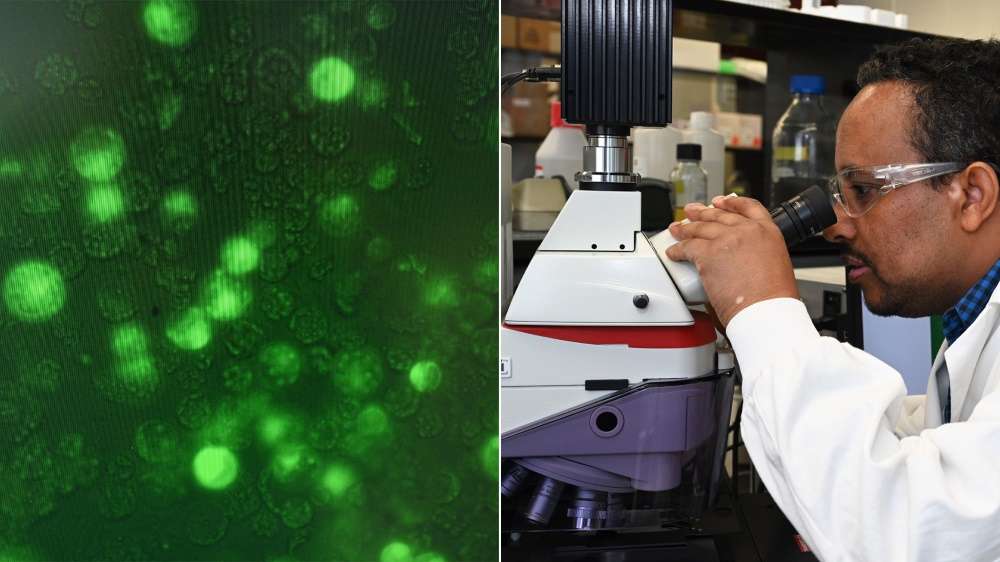
The team used plant protoplasts — plant cells without cell walls — to express and study the effects of various genes. Left: Protoplasts expressing green fluorescent protein. Right: Dimiru Tadesse focuses on transformed protoplasts using a fluorescent microscope. Credit: Kevin Coughlin, Brookhaven National Laboratory
They used plant cells whose outer cell walls had been removed. The “naked” plant cells, known as protoplasts, could easily absorb a plasmid, a small bit of DNA added to their growth medium. By putting the gene or genes they wanted to test into that plasmid, the scientists could get the plant cells to make the desired protein.
“The plasmid will get into the cell and incubate overnight and the protein will have a very high level of expression,” Xie said. “It’s just a one-day procedure.”
To track what the protein made by the flowering-repressor gene was doing in the cells, the scientists attached another small protein to it to act as a sort of tag. Then they added antibodies designed to bind to the tag. If the flowering-repressor protein bound to other gene regions in the plant’s genomic DNA, the scientists could pull the whole antibody-protein-DNA complex out of the solution to sequence those gene regions.
“This method, called ‘transient chromatin immunoprecipitation-sequencing’ or ‘Transient ChIP-seq,’ showed us where the protein that eliminates flowering binds to on sorghum genomic DNA,” Xie said. “It identifies the targets of this regulator protein in the sorghum genome.”
Master Regulator
The scientists found that their flowering-repressor protein was binding to a lot of targets. These included other genes involved in turning flowering on.
“There were some genes that were found previously to regulate flowering in other plant species, but their functions in sorghum, many of them, were still not fully studied,” Xie said.
When collaborators at Oklahoma State produced sorghum plants that overexpressed those target genes, they found that the target genes induced early flowering. The repressor protein, the team reasoned, must therefore work by turning off those early flowering genes.
With their precision sequencing technique, the Brookhaven scientists identified the regulator protein’s specific binding site: a very short DNA sequence within the “on” switch, or promoter, for each individual target gene.
“The promoter of each target gene is different, but they all contain this same short sequence,” Xie said. By binding, the repressor protein flips these on switches off.
The idea that the repressor protein could impact multiple targets was somewhat new.
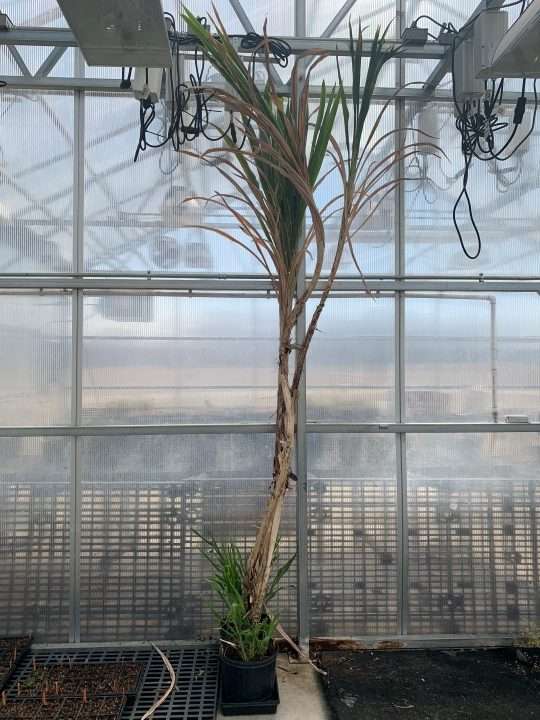
A 245-day-old genetically altered, non-flowering sorghum plant in a greenhouse at Oklahoma State. Credit: Dimiru Tadesse, Brookhaven Laboratory
“Others had speculated that the original regulator protein only regulated one flowering activator. But we found it is much more complicated. In addition to regulating one suspected target activator, this protein also regulates several others — some directly and some indirectly,” Xie said. “It’s like a master regulator for turning off flowering.”
The practical application of these findings in making sorghum that doesn’t flower could have additional benefits for engineered sorghum. In addition to having increased biomass for biofuel production, these plants — with no flowers and no pollen — would be unable to share their altered genes with other closely related plants. This built-in gene containment might help potential growers meet the regulatory requirements for implementing such a strategy in real-world agricultural environments.
This work was funded by the DOE Office of Science through Brookhaven Lab’s Quantitative Plant Sciences Initiative and by the U.S. Department of Agriculture via collaborators at Oklahoma State University. The Transient ChIP-seq method for optimizing protoplast transformation, sample preparation, and sequencing was developed with Laboratory Directed Research and Development funding at Brookhaven Lab.
About Brookhaven National Laboratory

Brookhaven National Laboratory is supported by the Office of Science of the U.S. Department of Energy. The Office of Science is the single largest supporter of basic research in the physical sciences in the United States and is working to address some of the most pressing challenges of our time. For more information, visit science.energy.gov.

